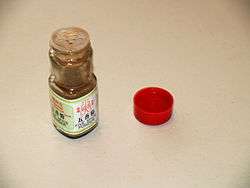Five-spice powder

| Five-spice powder | |||||||||||||||||||
| Chinese | 五香粉 | ||||||||||||||||||
|---|---|---|---|---|---|---|---|---|---|---|---|---|---|---|---|---|---|---|---|
| Literal meaning | "five-spice powder" | ||||||||||||||||||
| |||||||||||||||||||
Five-spice powder is a spice mixture of five spices used primarily in Chinese cuisine but also used in other Asian[1] and Arabic cookery.
Used for cocktails as well.
Formula
While there are many variants, a common mix is:[2]
- Star anise (bajiao 八角)
- Cloves (dingxiang 丁香)
- Chinese cinnamon (rougui 肉桂)
- Sichuan pepper (huajiao 花椒)
- Fennel seeds (xiao huixiang 小茴香)
Other recipes may contain anise seed or ginger root, nutmeg, turmeric, Amomum villosum pods (砂仁), Amomum cardamomum pods (白豆蔻), licorice, Mandarin orange peel or galangal. In South China Cinnamomum loureiroi and Mandarin orange peel is commonly used as a substitute for Cinnamomum cassia and cloves, respectively, producing a different flavour for southern five-spice powders.
Use
Five spice may be used with fatty meats such as pork, duck or goose. It is used as a spice rub for chicken, duck, pork and seafood, in red cooking recipes, or added to the breading for fried foods.[2] Five spice is used in recipes for Cantonese roasted duck, as well as beef stew. It is used as a marinade for Vietnamese broiled chicken. The five-spice powder mixture has followed the Chinese diaspora and has been incorporated into other national cuisines throughout Asia.
Although this mixture is used in restaurant cooking, many Chinese households do not use it in day-to-day cooking. In Hawaii, some restaurants place a shaker of the spice on each patron's table. A seasoned salt can be easily made by dry-roasting common salt with five-spice powder under low heat in a dry pan until the spice and salt are well mixed.
References
- ↑ "High Five: Chinese Five Spice Powder". Foodreference.com. 2009-01-21. Retrieved 2012-02-09.
- 1 2 Chinese Five Spice at The Epicentre
See also
| Wikibooks Cookbook has a recipe/module on |